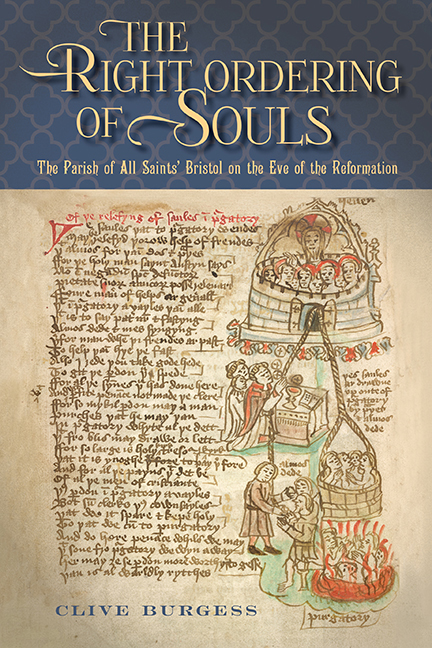Book contents
- Frontmatter
- Dedication
- Contents
- List of illustrations
- Acknowledgements
- Miscellaneous Frontmatter
- Abbreviations
- Notes
- map
- Part I For the increase of the divine service
- Part II All Saints’, Bristol, and its parishioners
- Part III Commemorating the dead
- Part IV Leaders and administrators
- Part V Ordering the parish
- Appendices
- Bibliography
- Glossary
- Index
- Miscellaneous Endmatter
Part II - All Saints’, Bristol, and its parishioners
Published online by Cambridge University Press: 05 May 2018
- Frontmatter
- Dedication
- Contents
- List of illustrations
- Acknowledgements
- Miscellaneous Frontmatter
- Abbreviations
- Notes
- map
- Part I For the increase of the divine service
- Part II All Saints’, Bristol, and its parishioners
- Part III Commemorating the dead
- Part IV Leaders and administrators
- Part V Ordering the parish
- Appendices
- Bibliography
- Glossary
- Index
- Miscellaneous Endmatter
Summary
AT first sight, All Saints’ may seem an odd choice for in-depth study. Even in Bristol other parishes appear more promising: why All Saints’ when, for instance, its neighbour, St Nicholas, was both larger and richer, or St Mary Redcliffe, in the southern suburb of the town, clearly ran a far more ambitious regime? The answer lies, simply, in the survival of evidence. Most English parishes can muster little, if anything, by way of archival evidence to shed light on their history before the Reformation. And while parishes in Bristol emerge as reasonably well-off for late medieval materials as compared with those, say, in late medieval York or Norwich – neither of which, wills apart, has any substantial holding of material reflective of parish life – All Saints’ preserves more than any other. Although we may be hard pressed to explain quite why, this particular parish possesses a remarkably rich pre-Reformation archive. It repays close study for the straightforward reason that, unusually, it can furnish sufficient data for an in-depth enquiry.
Parishes have never functioned in a vacuum: in the period in question, they occupied an increasingly prominent position among the array of institutions ministering to the political, as well as to the spiritual, interests of the realm, its rulers and their subjects. Local conditions naturally determined the manner in which parishioners might respond to incentives, not least insofar as economic trends governed the simple availability of means which, as a result, affected citizens’ ability to invest in their parishes. So the following provides, first, a brief outline of Bristol's fortunes, after which the focus turns to the parish of All Saints’ and to an examination of its archive which, as suggested, provides the rationale for this study. To set the scene more fully, some of the parish's more distinctive characteristics deserve attention; these raise questions concerning both its capabilities and its typicality – or not. Subsequent chapters in this section are concerned more with parishioners and, in the main, those active when the archive is at its most detailed towards the end of the fifteenth and in the early sixteenth centuries. They consider how belief found expression often in very generous behaviour.
- Type
- Chapter
- Information
- 'The Right Ordering of Souls'The Parish of All Saints’ Bristol on the Eve of the Reformation, pp. 57 - 58Publisher: Boydell & BrewerPrint publication year: 2018

